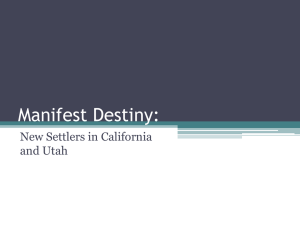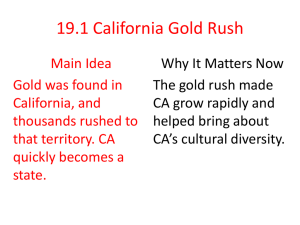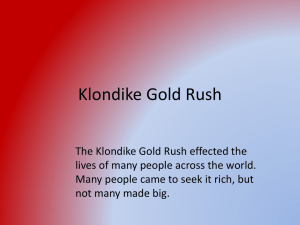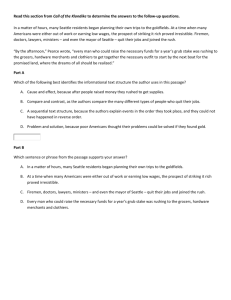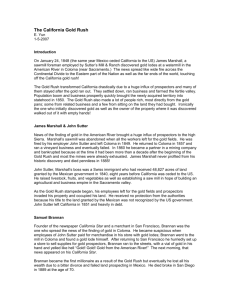The Gold Rush and the Foreign Miners' Tax
advertisement
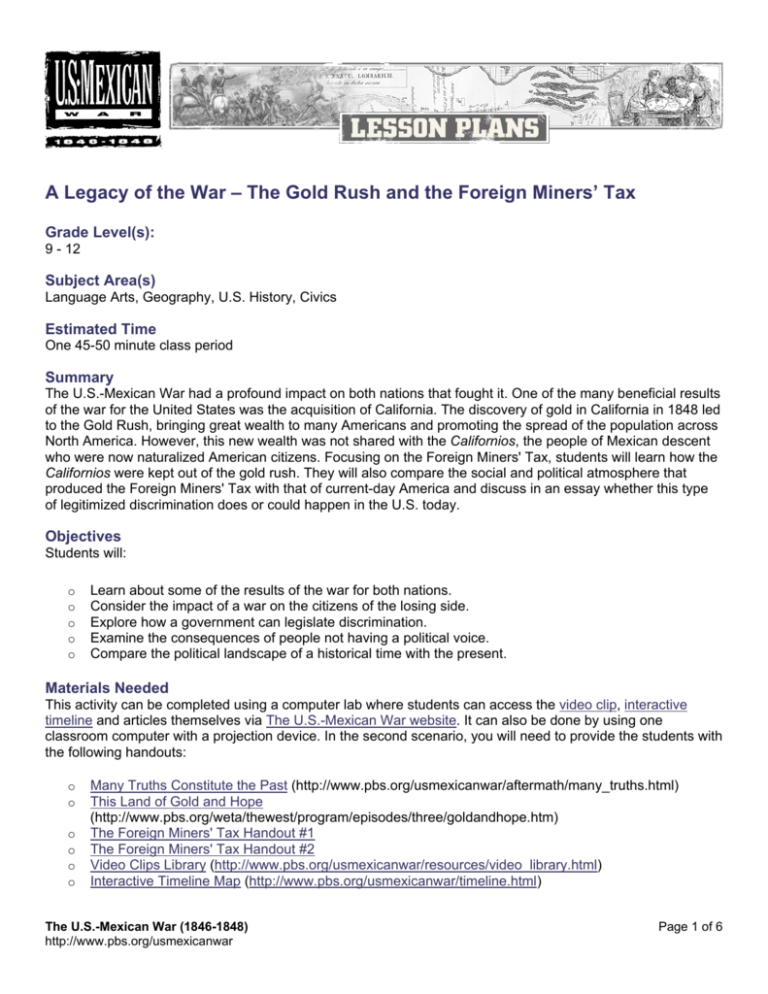
A Legacy of the War – The Gold Rush and the Foreign Miners’ Tax Grade Level(s): 9 - 12 Subject Area(s) Language Arts, Geography, U.S. History, Civics Estimated Time One 45-50 minute class period Summary The U.S.-Mexican War had a profound impact on both nations that fought it. One of the many beneficial results of the war for the United States was the acquisition of California. The discovery of gold in California in 1848 led to the Gold Rush, bringing great wealth to many Americans and promoting the spread of the population across North America. However, this new wealth was not shared with the Californios, the people of Mexican descent who were now naturalized American citizens. Focusing on the Foreign Miners' Tax, students will learn how the Californios were kept out of the gold rush. They will also compare the social and political atmosphere that produced the Foreign Miners' Tax with that of current-day America and discuss in an essay whether this type of legitimized discrimination does or could happen in the U.S. today. Objectives Students will: o o o o o Learn about some of the results of the war for both nations. Consider the impact of a war on the citizens of the losing side. Explore how a government can legislate discrimination. Examine the consequences of people not having a political voice. Compare the political landscape of a historical time with the present. Materials Needed This activity can be completed using a computer lab where students can access the video clip, interactive timeline and articles themselves via The U.S.-Mexican War website. It can also be done by using one classroom computer with a projection device. In the second scenario, you will need to provide the students with the following handouts: o o o o o o Many Truths Constitute the Past (http://www.pbs.org/usmexicanwar/aftermath/many_truths.html) This Land of Gold and Hope (http://www.pbs.org/weta/thewest/program/episodes/three/goldandhope.htm) The Foreign Miners' Tax Handout #1 The Foreign Miners' Tax Handout #2 Video Clips Library (http://www.pbs.org/usmexicanwar/resources/video_library.html) Interactive Timeline Map (http://www.pbs.org/usmexicanwar/timeline.html) The U.S.-Mexican War (1846-1848) http://www.pbs.org/usmexicanwar Page 1 of 6 Video clip used: • “The Gold Rush: Who got left behind?” Procedure Pre-viewing Activity: Explain to students that the U.S.-Mexican War had a huge impact on both countries that fought it. This is most obvious in the fact that the United States gained a very large amount of territory from Mexico as a result of winning the war. One of the major territories that it gained was California. Gold was discovered in California in January, 1848, about a month before the Treaty of Guadalupe Hidalgo was signed, ending the war. This led to the Gold Rush and great wealth for many Americans (and a massive population shift across North America). However, the Californios, people of Mexican descent who lived in California and who had been granted American citizenship, did not benefit from the gold rush, largely as a result of the Foreign Miners' Tax. Highlight to the students that the Californios were legally American citizens, and they shouldn't have been affected by a law meant to impact "foreigners." Ask the students to think about how governments have favored one group over another by restricting the rights and privileges of some citizens. Go over The Foreign Miners' Tax Handout #1 with the students. Explain that they should use the handout to help focus their learning as they watch a short video clip, explore the interactive timeline and read two articles. Briefly review the following topics from the handout with the students: o o o o o When the Gold Rush occurred in relation to the end of the war. The treatment of the Californios, Tejanos and others by the U.S. government after the war. The circumstances that led to the Foreign Miners' Tax. The impact of the Foreign Miners' Tax on the Californios. The effect on a people when they lack political power. Explain to the students that after doing their research, they will write an essay incorporating some of their new learning. Viewing Activity: Tell students to go to “The U.S.-Mexican War” website to access the short video clip “The Gold Rush: Who got left behind?” (or display the video with a projection device in your classroom). Then have the students access the interactive timeline on the same site to further research the relevant information on the Californios and the Gold Rush. Finally, have the students read the following two articles (referred to above), either online or as handouts: Many Truths Constitute the Past and This Land of Gold and Hope. (If you think you might be short of time, have the students read only the second article as there is some overlap between the first one and the video clip.) Again, remind the students to use their handouts to focus their research. Post-viewing Activity: After students have completed their research, review some of the material with them. Go over the specifics of the Foreign Miners' Tax to make sure that they have a good grasp on the subject. Have the students discuss their opinions about what they've learned. Now tell the students that they will be taking what they have learned about the past and applying it in the context of what they know about the present. Have them use the Foreign Miners' Tax Handout #2 as a guide to write a short essay comparing the environment of Gold Rush California with the current-day United States. Do The U.S.-Mexican War (1846-1848) http://www.pbs.org/usmexicanwar Page 2 of 6 they think that the kind of legitimized discrimination represented by the Foreign Miners' Tax does or could exist in the United States today? Have them compare and/or contrast the two eras to back up their opinions. When the students have completed their essays, have them share them with their classmates to elicit feedback and further a discussion on the topic. Classroom Assessment To assess the students' work, consider the following: o o o Did the students show an understanding of the material about the Californios and the Gold Rush (consider giving them a short quiz on the topics from the first worksheet to find out)? Did the students present their ideas clearly and persuasively in their essays? Did the students' essays show their understanding of the material in the feedback they offered their classmates? Extensions and Applications Have the students create a timeline of the political events (in particular, the laws passed by the California legislature) that impacted the Californios in the immediate post-war years. The students can use the following web articles as starting points for their research: o o o o http://www.learncalifornia.org/doc.asp?id=1933&pagetype=content http://www.digitalhistory.uh.edu/mexican_voices/voices_display.cfm?id=68 http://www.cr.nps.gov/history/online_books/5views/5views5b.htm http://memory.loc.gov/ammem/cbhtml/cbrush.html National Standards McRel K-12 Standards Addressed: Language Arts o o o Standard 1: Uses the general skills and strategies of the writing process. Standard 4: Gathers and uses information for research purposes. Standard 7: Uses reading skills and strategies to understand and interpret a variety of informational texts. Geography o o o o o Standard 1: Understands the characteristics and uses of maps, globes, and other geographic tools and technologies. Standard 9: Understands the nature, distribution and migration of human populations on Earth's surface. Standard 12: Understands the patterns of human settlement and their causes. Standard 13: Understands the forces of cooperation and conflict that shape the divisions of Earth's surface. Standard 16: Understands the changes that occur in the meaning, use, distribution and importance of resources. The U.S.-Mexican War (1846-1848) http://www.pbs.org/usmexicanwar Page 3 of 6 o Standard 17: Understands how geography is used to interpret the past. U.S. History o o Standard 9: Understands the United States territorial expansion between 1801 and 1861, and how it affected relations with external powers and Native Americans. Standard 10: how the industrial revolution, increasing immigration, the rapid expansion of slavery, and the westward movement changed American lives and led to regional tensions. Civics o o o Standard 13: Understands the character of American political and social conflict and factors that tend to prevent or lower its intensity. Standard 14: Understands issues concerning the disparities between ideals and reality in American political and social life. Standard 25: Understands issues regarding personal, political, and economic rights. Online Resources Below are the links for sites referenced in this activity: o The U.S.-Mexican War (1846 - 1848) http://www.pbs.org/usmexicanwar/ o Background on the Gold Rush and the Foreign Miners' Tax http://www.pbs.org/weta/thewest/program/episodes/three/goldandhope.htm o Background on the Californios http://www.learncalifornia.org/doc.asp?id=1933&pagetype=content http://www.digitalhistory.uh.edu/mexican_voices/voices_display.cfm?id=68 http://www.cr.nps.gov/history/online_books/5views/5views5b.htm http://memory.loc.gov/ammem/cbhtml/cbrush.html The U.S.-Mexican War (1846-1848) http://www.pbs.org/usmexicanwar Page 4 of 6 The Foreign Miners’ Tax Handout #1 The following are some of the topics you should focus on as you watch the video clip and read the articles: 1. When the Gold Rush occurred in relation to the end of the war. 2. The treatment of the Californios, Tejanos and others by the U.S. government after the war. 3. The circumstances that led to the Foreign Miners' Tax. 4. The impact of the Foreign Miners' Tax on the Californios. 5. The effect on a people when they lack political power. The U.S.-Mexican War (1846-1848) http://www.pbs.org/usmexicanwar Page 5 of 6 The Foreign Miners’ Tax Handout #2 The Foreign Miners' Tax did not just affect "foreigners" in California. The Californios, people of Mexican descent who had lived in the territory for many years, had been granted U.S. citizenship after the war. Yet they were forced to pay the Foreign Miners' Tax if they wanted to mine for gold in California. While this law was repealed after only a year, it produced its desired result: the prohibitive tax left most of the gold to the Americans of Anglo descent. Based on what you know about the current social and political landscape, do you think that this type of discrimination does or could happen today in the United States? Why? Why not? What is different about today's United States compared to that of 1850? What might be the same? The U.S.-Mexican War (1846-1848) http://www.pbs.org/usmexicanwar Page 6 of 6

